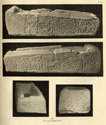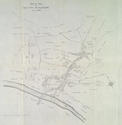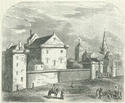 Glasgow stands on the Clyde, about 15 miles upstream from the river's estuary. The proximity of a good ford probably attracted settlers in the Neolithic and Bronze Ages. A Roman presence can also be detected but there is no evidence of a Roman settlement.
Glasgow stands on the Clyde, about 15 miles upstream from the river's estuary. The proximity of a good ford probably attracted settlers in the Neolithic and Bronze Ages. A Roman presence can also be detected but there is no evidence of a Roman settlement.
Origins
 The city's origins are unclear. Traditionally, St Kentigern (also known as Mungo, c 518-c 603) is supposed to have founded a monastery beside the Molendinar burn, three-quarters of a mile north of the ford. This became the seat of a bishopric, a place of pilgrimage and hence a settlement. An alternative view concerns Govan, about 2 miles downstream on the south side of the Clyde where ancient burials raise the possibility of an important royal centre which could have become an episcopal centre. The bishopric was then translated to the Molendinar site in the 11th or early 12th centuries when the cult of St Kentigern was being fostered.
The city's origins are unclear. Traditionally, St Kentigern (also known as Mungo, c 518-c 603) is supposed to have founded a monastery beside the Molendinar burn, three-quarters of a mile north of the ford. This became the seat of a bishopric, a place of pilgrimage and hence a settlement. An alternative view concerns Govan, about 2 miles downstream on the south side of the Clyde where ancient burials raise the possibility of an important royal centre which could have become an episcopal centre. The bishopric was then translated to the Molendinar site in the 11th or early 12th centuries when the cult of St Kentigern was being fostered.
 In the early 12th century, the picture becomes clearer. In 1136 a cathedral was consecrated (or re-consecrated) on the banks of the Molendinar and thereafter the existence of an episcopal centre at Glasgow is well attested. Alongside the cathedral a settlement with a market developed to serve the needs of the clerics and laity with business at the bishops' court.
In the early 12th century, the picture becomes clearer. In 1136 a cathedral was consecrated (or re-consecrated) on the banks of the Molendinar and thereafter the existence of an episcopal centre at Glasgow is well attested. Alongside the cathedral a settlement with a market developed to serve the needs of the clerics and laity with business at the bishops' court.
The Burgh's Foundation
 During the 12th century the Scottish crown imported from England the practice of granting certain towns exclusive trading and self-governing privileges so that they could become centres of prosperity and stability. In return for such privileges, these "king's burghs" paid revenues to the crown, their "superior". Early examples included Edinburgh, Aberdeen, Dundee and Perth, and Glasgow's neighbours Renfrew, Rutherglen and Dumbarton.
During the 12th century the Scottish crown imported from England the practice of granting certain towns exclusive trading and self-governing privileges so that they could become centres of prosperity and stability. In return for such privileges, these "king's burghs" paid revenues to the crown, their "superior". Early examples included Edinburgh, Aberdeen, Dundee and Perth, and Glasgow's neighbours Renfrew, Rutherglen and Dumbarton.
 The crown also allowed the nobility and the church to have burghs. Some time between 1175 and 1178, Bishop Jocelin of Glasgow obtained a royal charter authorising the bishops to have a burgh at Glasgow.
The crown also allowed the nobility and the church to have burghs. Some time between 1175 and 1178, Bishop Jocelin of Glasgow obtained a royal charter authorising the bishops to have a burgh at Glasgow.
 Glasgow's charter gave it rights almost equal to those enjoyed by the king's burghs. Glasgow was to have a weekly market and its economy was further enhanced during the 1190s when the bishops received the grant of an annual fair, a sort of super-market at which trade was open to both burgesses and strangers.
Glasgow's charter gave it rights almost equal to those enjoyed by the king's burghs. Glasgow was to have a weekly market and its economy was further enhanced during the 1190s when the bishops received the grant of an annual fair, a sort of super-market at which trade was open to both burgesses and strangers.
Growth
 A late twelfth century reference to "the first building of the burgh" probably concerns activity south of the cathedral in the area now known as Glasgow Cross. Here the road from the cathedral to the Clyde (High Street/Saltmarket/Bridgegate) meets the road (Trongate/Gallowgate) from Dumbarton to Lanark. Comparative closeness to the river made this site well suited as a market place.
Glasgow's built-up area thus comprised two nuclei - one around the cathedral, the other at the market cross. Between and around these lay lands used for pasturage and fuel. Like their rural neighbours, the burgh's inhabitants farmed crops and tended livestock. Their lands (burgage plots) were laid out in long narrow strips at right angles to the main thoroughfares, fronted by tenements and booths with, behind, backlands containing gardens and outhouses. Like most Scottish burghs, Glasgow was not walled. Ditches or small palisades delineated the burgh's boundaries and secured the burgesses' livestock. Ports (or gates) were used as toll collection points rather than for defensive purposes.
A late twelfth century reference to "the first building of the burgh" probably concerns activity south of the cathedral in the area now known as Glasgow Cross. Here the road from the cathedral to the Clyde (High Street/Saltmarket/Bridgegate) meets the road (Trongate/Gallowgate) from Dumbarton to Lanark. Comparative closeness to the river made this site well suited as a market place.
Glasgow's built-up area thus comprised two nuclei - one around the cathedral, the other at the market cross. Between and around these lay lands used for pasturage and fuel. Like their rural neighbours, the burgh's inhabitants farmed crops and tended livestock. Their lands (burgage plots) were laid out in long narrow strips at right angles to the main thoroughfares, fronted by tenements and booths with, behind, backlands containing gardens and outhouses. Like most Scottish burghs, Glasgow was not walled. Ditches or small palisades delineated the burgh's boundaries and secured the burgesses' livestock. Ports (or gates) were used as toll collection points rather than for defensive purposes.
The area north of the cross remained largely undeveloped although it was here, on the east side of the later High Street, that the Dominicans (Black Friars) were granted property in 1246. Instead, spreading south-west from the market cross along the line of the later Bridgegate, the burgh reached the river by the late 13th century. By this time, c 1285, there was a wooden bridge, supplementing the ford. The early 14th century saw the burgh extending eastwards along the Gallowgate and westwards along Trongate but neither movement represented much more than ribbon development. The burgh remained small during the medieval period, its population probably not exceeding 1,500 inhabitants.
New Privileges
The Scottish crown had many burghs and could not support them directly. Several burghs struggled to succeed economically, and some failed altogether. Renfrew and Rutherglen, both king's burghs and potential rivals of Glasgow, never really took off. As Glasgow's bishops owned only one burgh, and they were influential lords, they were more easily able to secure Glasgow's prosperity. Further royal grants enhanced Glasgow's trading privileges and, thereby, the income accruing to the burgh's episcopal superiors from market tolls and rents.
In 1450, the bishops were granted "regality" jurisdiction over their possessions, with the associated privileges. This benefited Glasgow, allowing it to maintain its position just as strict demarcation lines were being drawn between the royal burghs (as the king's burghs were now known) and other burghs, particularly in the lucrative area of foreign trade. So, when the bishops were allowed in 1490 to collect for their own uses the great customs on hides, wool, cloth and various foodstuffs normally reserved to the crown, Glasgow's burgesses were simultaneously confirmed in their right to export such goods, like their counterparts in royal burghs. Later that year, Glasgow was the only non-royal burgh to feature in a list of "frie burghs" in the west allowed to receive imports. The burgh's economic reach must also have been enhanced when the see of Glasgow became an archbishopric in 1492, the territorial jurisdiction of the Glasgow bishops' court thereby being extended to cover the dioceses of Argyll, Dunblane, Dunkeld and Galloway.
New Foundations
The 15th century also saw several important foundations. Most significant was the founding of the University of Glasgow by Pope Nicholas V in 1451. It would remain very small for several centuries, yet the presence of masters and students probably had some beneficial effects on the local economy. The University also put Glasgow's name on the European map, a matter of no small significance.
Other substantial foundations followed. In the 1470s, the Franciscans (Grey Friars) built their monastery on High Street, west of the Blackfriars monastery and the University. Several churches were established, the largest being the collegiate church of St Mary and St Anne (later known as the Tron church) on Trongate, founded in 1525. Many gifts of property were made to the church. There was a vogue for such donations at that time across Europe, but their appearance in Glasgow does reflect confidence in the health of the local economy.
Administering the Burgh
Glasgow's foundation charter, like those of other burghs, made no reference to how the burgh was to be administered. Late 13th century documents confirm the existence of a burgh court regulating land conveyances, supervised by officials (prepositi et ballivi) who were servants of the bishop. The transactions were witnessed by panels (assizes) of the court, consisting of around twelve men. Further attestation was provided by the burgh's common seal, signifying the concept of a corporation acting for the community. However, the burgh was passing income from rents (and presumably market tolls) to the bishops at this time.
By 1500 several significant developments had occurred. Income from rents and tolls were being credited to the town's own accounts (its "common good"), the bishops receiving instead an annual set payment. Non-legal administrative matters had been delegated from the court to a council - the earliest direct reference to Glasgow's town council is found in 1501, but it had probably developed much earlier from the assizes referred to above. Also, the bishops' officers (prepositi et ballivi) had become the provost and bailies.
The provost was the senior magistrate and executive officer of the burgh and the bailies were his assistants. The provost was appointed by the archbishop, usually from the ranks of the local gentry - he was not yet the community's leader. As for the bailies of the burgh, the sitting magistrates and council were required to produce a short list each year from which the superior chose these officers.
So, by the early 16th century (if not before), the bishops had allowed Glasgow some self-governance, almost certainly in response to its growing self-assuredness and prosperity, and the knowledge that limited freedoms encouraged that prosperity.
Economic Performance
In the mediaeval period, Glasgow's foreign trade was probably very slight - European trade was much easier for the burghs on the east coast. Glasgow was essentially a provincial market town, trading principally with its immediate hinterland, the Clyde estuary, Argyll and the inner isles, though even here its position was far from ideal because of the shallows in the Clyde. In its favour were the generous terms of its charters, the patronage of its bishops, and its position which largely kept it out of the political limelight. Glasgow prospered quietly.
An examination of Glasgow's contributions to two national taxes, levied two centuries apart, is instructive. In 1367, Glasgow's share and ranking were 0.9 per cent and twenty-first, less than its Clyde neighbours and very far behind the leading east coast burghs. By 1557, Glasgow had overtaken most of the other Clyde burghs with a contribution of 2 per cent (ninth), though it was still far behind Edinburgh, Dundee, Aberdeen and Perth. Though not yet a royal burgh, Glasgow had been represented in Parliament from 1546 and on the Convention of Royal Burghs from at least 1552, reflecting its taxable capacity. Glasgow was on the "up escalator" on the eve of the Reformation.